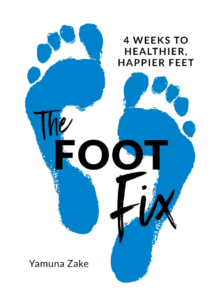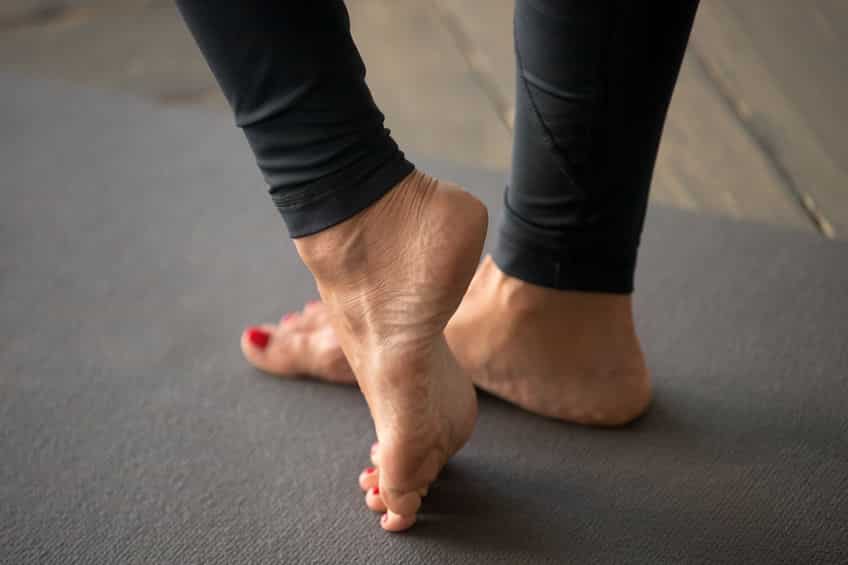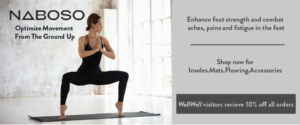The feet are the foundation of the body, yet they’re often ignored. This can lead to common issues that trickle down (or up) the entire body. Luckily, Yamuna Zake has the fix. As a master teacher of body sustainability and author of The Foot Fix: 4 Weeks to Healthier, Happier Feet, she’s uniquely qualified. Yamuna recently spoke to WellWell on the various foot mistakes commonly made, often ignored and how we can correct them.
The Foot Fix aims to improve common mistakes for better overall functioning, how did you discover these issues and how to handle them?
I had working with bodies and helping people overcome injuries and pain over the years and no matter what the problem was, after having them walk and move, it always became so obvious there was some link to the feet. I wanted to educate on a key body part that was often overlooked.
What were some of these issues?
The big ones are knee, hip, or lower back problems and posture in general. They’re all very common and so often connected to issues with the feet but rarely treated that way.
Are people generally born with these foot problems or do they develop over time?
It’s both due to genetics and habitual patterns over the years. For many years, people use to say to me, “Well, you know, my father has flat feet. My brother has flat feet. My grandfather had flat feet, so I have flat feet.” They’d think it’s like this family curse and just accept it. But it doesn’t have to be. Any genetics we know that are structural, you can turn around. I saw that my mother had a bad hammer toe which has led to almost no balance in her feet now at 90 years old. I decided that I didn’t want that for myself and so I started working on my own feet, doing a daily practice to keep them working and keep them mindfully connecting of the rest of my body.
The Foot Fix mentions that 77 percent of people over 50 suffer from some form of foot pain. Do these bad habits we develop tend to worsen over time? Why do you think that number is so high for people over 50?
The body is really forgiving so for the first 50 years of your life, you can get away with ignoring foot pain. You still have juicy collagen and healthier muscle tendons and ligaments when you’re younger. But as you age, the skeletal and soft tissue starts to get beat up and not recover so easily. So those bad patterns that never bothered you in your life suddenly start showing up. But they were always there. Of course, then you also have people that had injuries when they were younger they never noticed that will eventually show up.
How does the placement of your foot, its arch and how you move it impact the entire body?
In The Foot Fix, I try to make that all very simple, so I introduce people to each part of their foot so that they actually go through the process of seeing how to build a healthy arch in their feet. We’re so accustomed to shoes sticking arches on the inner side of the foot right in front of the heel. But that doesn’t build your arch, that’s just a band aid. So, when I get people to actually begin to walk through the outside of their foot and use it and engage their toes and actually get spring flexibility in their toes and get them to stand in their heels, they start to feel what each part of the foot does.
What role does footwear play in this?
Part of what I’ve learned over the years from all the classes and lectures that I’ve given, the most asked question is “What shoes do you recommend?” And the marketing from shoe companies is just phenomenal. They all try to tell you why their shoe is the best for you. What I say is, “Get to know your own feet. Get your own feet working properly and then it doesn’t matter what shoe you wear.”
The book mentions that it really only takes about 10 to 15 minutes a day to focus on feet to correct a lot of these issues. What are some simple techniques that people can use to either determine whether they have a foot issue?
It’s the walking test. I developed it to see if someone is using their whole foot in every step that they take. It’s simple but telling. Everyone can easily determine if they have a foot problem. But even when you don’t have a foot problem and you go through the walking test; you immediately see where you don’t use your foot. And so, wherever you don’t use your foot is eventually going to cause you a problem. It’s basically getting people to turn all the parts of their feet on so they’re working again. Once you start paying attention to it, if you walk down any city street, you’ll shake your head because you’ll notice how prevalent and ignored these issues are.
You’ll notice this from seeing people’s posture as they walk?
Oh yes. If you watch people you can see how that arch is collapsing or that person’s wearing the heel of their shoe down. Oh, those ankles are swollen. Okay, that person can hardly move their leg. You start seeing all these things and the feet are at the end of them. It should show how much the feet are neglected and how necessary it is to switch them back on.
How does your approach differ from the traditional medical approach?
I very specifically wanted to make The Foot Fix non-medical because what often happens when someone gets a diagnosis is their doctor will never tell them how they did this to themselves and what do they need to do to correct it going forward. They’ll throw out intimating medical terms with and usually just quick fixes, not long-term solutions. I wanted to make it simple for people and not intimidate them with the medical terms. That way they can be successful and correct their own bodies. That’s really the foot fix.
 About Yamuna Zake
About Yamuna Zake
Yamuna Zake is a master teacher of body sustainability and creator of the global brand Yamuna®. She is the author of The Foot Fix: 4 Weeks to Healthier, Happier Feet, The Ultimate Body Rolling Workout: The Revolutionary Way to Tone, Lengthen, and Realign Your Body, and Body Rolling: An Experiential Approach to Complete Muscle Release.
Learn More at www.yamunausa.com













